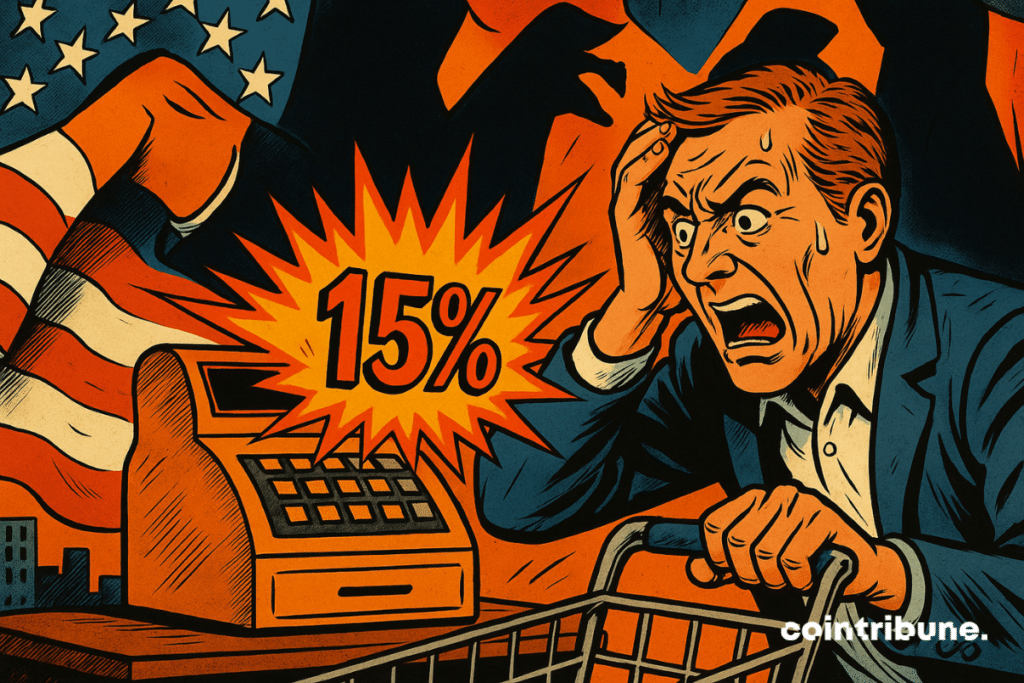Trump’s Tariffs Ignite Inflation Firestorm—Here’s What It Means for Your Wallet
Trade wars just got real—and your grocery bill’s taking the hit.
### The Tariff Tinderbox
Former President Trump’s signature tariffs are back with a vengeance, sending consumer prices skyrocketing like a shitcoin on leverage. Supply chains? More like supply pains.
### Main Street Feels the Burn
From Walmart aisles to gas pumps, Americans are getting squeezed harder than a Bitcoin miner during a halving. Economists whisper ‘stagflation’—Wall Street shrugs and buys gold.
### The Crypto Wildcard
While fiat currencies flounder, decentralized assets smirk from the sidelines. Another day, another dollar devaluation—good thing Satoshi built an inflation hedge.
Wake-up call: protectionism has a price tag… and guess who’s footing the bill? (Spoiler: It’s always you.)

In brief
- Inflation rose sharply in June in the United States, reaching 2.7%, due to tariffs imposed by Donald Trump.
- Prices of goods affected by these taxes, such as furniture and appliances, increased significantly.
- In response, the Federal Reserve hesitates to cut rates, fearing economic stagnation accompanied by rising prices.
Inflation surges with tariffs
In the USA, inflation increased by 2.7% year-on-year in June, its fastest pace since February. This rise is largely due to the tariffs imposed by Donald Trump. Furniture, appliances, and clothing have seen their prices rise. Products most affected by the taxes have become more expensive for companies, which have chosen to pass this cost on to consumers.
Gasoline prices have also increased, as have food prices. The increases are not huge, but they add up. As a result, households are paying more without necessarily consuming more. And this is just the beginning. New taxes are planned in the coming weeks, which could further worsen the situation.
This return of inflation comes at a delicate time for the economy. Wages are not rising at the same pace, and purchasing power is beginning to decline. The trade war wanted by Trump, intended to protect the American economy, seems for now to be weighing on Americans’ wallets.
The Fed remains immobile amid tensions
Faced with rising inflation, the Federal Reserve (the American central bank) prefers not to move. It keeps interest rates stable because the situation is difficult to read. On one hand, the economy is slowing slightly. On the other, prices are rising. Lowering rates could stimulate growth, but it could also further fuel inflation.
Some officials want to act quickly, others prefer to wait. In the meantime, the Fed maintains a cautious stance. It wants first to better understand how Trump’s economic measures will impact the economy in the long term. Tax cuts, deregulation, and tariffs create many uncertainties.
President TRUMP himself continues to apply pressure. He demands lower rates, going so far as to ask for a three-point cut. According to him, inflation remains low. But the recently published figures say otherwise. For the Fed, now is not the time to take risks.
The risk of economic deadlock
What economists now fear is stagflation. This is a rare phenomenon where prices rise while the economy slows. This scenario complicates everything. The Fed can no longer lower rates to boost growth, as that WOULD push prices even higher.
Many companies find themselves in a difficult situation. They have to choose between absorbing costs related to tariffs, which reduces their profits, or raising prices, which can drive away customers. In any case, the economy slows and prices rise: a difficult cycle to break.
For now, some prices remain down, like those of cars or plane tickets. But these are exceptions. If trade tensions continue, other sectors risk following the same trend as appliances or clothing.
Maximize your Cointribune experience with our "Read to Earn" program! For every article you read, earn points and access exclusive rewards. Sign up now and start earning benefits.

